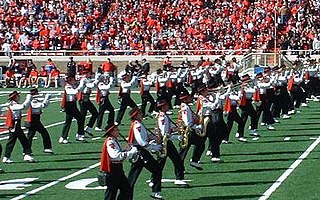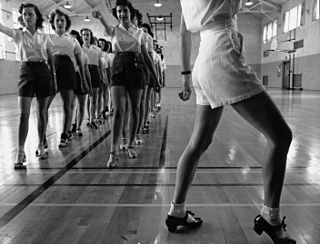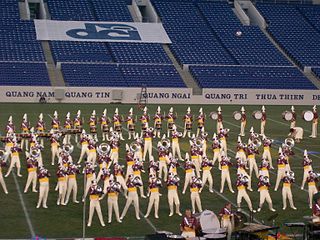
A drum kit is a collection of drums, cymbals, and sometimes other auxiliary percussion instruments set up to be played by one person. The drummer typically holds a pair of matching drumsticks, and uses their feet to operate hi-hat and bass drum pedals.

A percussion instrument is a musical instrument that is sounded by being struck or scraped by a beater including attached or enclosed beaters or rattles struck, scraped or rubbed by hand or struck against another similar instrument. Excluding zoomusicological instruments and the human voice, the percussion family is believed to include the oldest musical instruments. In spite of being a very common term to designate instruments, and to relate them to their players, the percussionists, percussion is not a systematic classificatory category of instruments, as described by the scientific field of organology. It is shown below that percussion instruments may belong to the organological classes of idiophone, membranophone, aerophone and cordophone.

A marching band is a group of instrumental musicians who perform while marching, often for entertainment or competition. They are most popular in the United States, though not uncommon in other parts of the world. Instrumentation typically includes brass, woodwind, and percussion instruments. Most marching bands wear a uniform, often of a military style, that includes an associated organization's colors, name or symbol. Most high school marching bands, and some college marching bands, are accompanied by a color guard, a group of performers who add a visual interpretation to the music through the use of props, most often flags, rifles, and sabers.

The bass drum is a large drum that produces a note of low definite or indefinite pitch. The instrument is typically cylindrical, with the drum's diameter much greater than the drum's depth, with a struck head at both ends of the cylinder. The heads may be made of calfskin or plastic and there is normally a means of adjusting the tension either by threaded taps or by strings. Bass drums are built in a variety of sizes, but size does not dictate the volume produced by the drum. The pitch and the sound can vary much with different sizes, but the size is also chosen based on convenience and aesthetics. Bass drums are percussion instruments and vary in size and are used in several musical genres. Three major types of bass drums can be distinguished.

Tap dance is a form of dance characterized by using the sounds of tap shoes striking the floor as a form of percussion and is often accompanied by music. Tap dancing can also be done using an a cappella method, in which no musical accompaniment is provided, and dancers create their own "music" through the sounds of their taps.

A modern drum and bugle corps is a musical marching unit consisting of brass instruments, percussion instruments, electronic instruments, and color guard. Typically operating as independent non-profit organizations, corps perform in competitions, parades, festivals, and other civic functions. Participants of all ages are represented within the corps activity, but the majority are between the ages of 13 and 22 and are members of corps within Drum Corps International or Drum Corps Associates.

Beatboxing is a form of vocal percussion primarily involving the art of mimicking drum machines, using one's mouth, lips, tongue, and voice. It may also involve vocal imitation of turntablism, and other musical instruments. Beatboxing today is connected with hip-hop culture, often referred to as "the fifth element" of hip-hop, although it is not limited to hip-hop music. The term "beatboxing" is sometimes used to refer to vocal percussion in general.

The conga, also known as tumbadora, is a tall, narrow, single-headed drum from Cuba. Congas are staved like barrels and classified into three types: quinto, tres dos or tres golpes (middle), and tumba or salidor (lowest). Congas were originally used in Afro-Cuban music genres such as conga and rumba, where each drummer would play a single drum. Following numerous innovations in conga drumming and construction during the mid-20th century, as well as its internationalization, it became increasingly common for drummers to play two or three drums. Congas have become a popular instrument in many forms of Latin music such as son, descarga, Afro-Cuban jazz, salsa, songo, merengue and Latin rock.

The ghaṭam is a percussion instrument used in various repertoires across India especially in Southern India. It's variant is played in Punjab and known as gharha as it is a part of Punjabi folk traditions. Its analogue in Rajasthan is known as the madga and pani mataqa.

Zills or zils, also called finger cymbals, are small metallic cymbals used in belly dancing and similar performances. They are called sāgāt in Egypt. They are similar to Tibetan tingsha bells. In Western music, several pairs can be set in a frame to make a tambourine.
A rimshot is a percussion technique used to produce an accented snare drum backbeat. The sound is produced by simultaneously hitting the rim and head of a drum with a drum stick.

The term Chinese orchestra is most commonly used to refer to the modern Chinese orchestra that is found in China and various overseas Chinese communities. This modern Chinese orchestra first developed out of Jiangnan sizhu ensemble in the 1920s into a form that is based on the structure and principles of a Western symphony orchestra but using Chinese instruments. The orchestra is divided into four sections – wind, plucked strings, bowed strings, and percussion, and usually performs modernized traditional music called guoyue. The orchestra may be referred to as Minzu Yuetuan or Minyuetuan in mainland China, Chung Ngok Tuen in Hong Kong, Huayuetuan in Southeast Asia, or Guoyuetuan in Taiwan, all meaning Chinese orchestra.

A flamenco guitar is a guitar similar to a classical guitar but with thinner tops and less internal bracing. It usually has nylon strings, like the classical guitar, but it generally possesses a livelier, more gritty sound compared to the classical guitar. It is used in toque, the guitar-playing part of the art of flamenco.
Tap dance makes frequent use of syncopation. Tap dance choreographies typically start on the eighth beat, or between the eighth and the first count.

Irish stepdance is a style of performance dance with its roots in traditional Irish dance. It is generally characterized by a stiff upper body and fast and precise movements of the feet. It can be performed solo or in groups. Aside from public dance performances, there are also stepdance competitions all over the world. These competitions are often called Feiseanna. In Irish dance culture, a Feis is a traditional Gaelic arts and culture festival. Costumes are considered important for stage presence in competition and performance Irish stepdance. In many cases, costumes are sold at high prices and can even be custom made. Each costume is different, with varying colors and patterns, designed to attract the judge's eye in competitions and the audience's eye in performance. General appearance beside the costume is also equally important. Female dancers would typically curl their hair before each competition or wear curled wigs, while male dancers would neatly style their hair to a shape to their liking. Poodle Socks are worn by female dancers while males wear plain black socks. Poodle socks are white socks that stretch to typically 1-4 inches above the ankle, depending on the dancers preference. They also have distinctive ribbing, and can be embroidered with gems.

An acoustic guitar is a musical instrument in the string family. When a string is plucked, its vibration is transmitted from the bridge, resonating throughout the top of the guitar. It is also transmitted to the side and back of the instrument, resonating through the air in the body, and producing sound from the sound hole. The original, general term for this stringed instrument is guitar, and the retronym 'acoustic guitar' distinguishes it from an electric guitar, which relies on electronic amplification. Typically, a guitar's body is a sound box, of which the top side serves as a sound board that enhances the vibration sounds of the strings. In standard tuning the guitar's six strings are tuned (low to high) E2 A2 D3 G3 B3 E4.

A clapper is a basic form of percussion instrument. It consists of two long solid pieces that are struck together producing sound. A straightforward instrument to produce and play, they exist in many forms in many different cultures around the world. Clappers can take a number of forms and be made of a wide variety of material. Wood is most common, but metal and ivory have also been used. The plastic thundersticks that have recently come to be popular at sporting events can be considered a form of inflated plastic clapper.
String instruments are capable of producing a variety of extended technique sounds. These alternative playing techniques have been used extensively since the 20th century. Particularly famous examples of string instrument extended technique can be found in the music of Krzysztof Penderecki, Witold Lutosławski, George Crumb, and Helmut Lachenmann.
Sean-nós dance is an older style of traditional solo Irish dance. It is a casual dance form, as opposed to the more formal and competition-oriented form of Irish stepdance.

In music, "noise" has been variously described as unpitched, indeterminate, uncontrolled, convoluted, unmelodic, loud, otherwise unmusical, or unwanted sound, or simply as sound in general. The exact definition is often a matter of both cultural norms and personal tastes. Noise is an important component of the sound of the human voice and all musical instruments, particularly in unpitched percussion instruments and electric guitars. Electronic instruments create various colours of noise. Traditional uses of noise are unrestricted, using all the frequencies associated with pitch and timbre, such as the white noise component of a drum roll on a snare drum, or the transients present in the prefix of the sounds of some organ pipes.
















